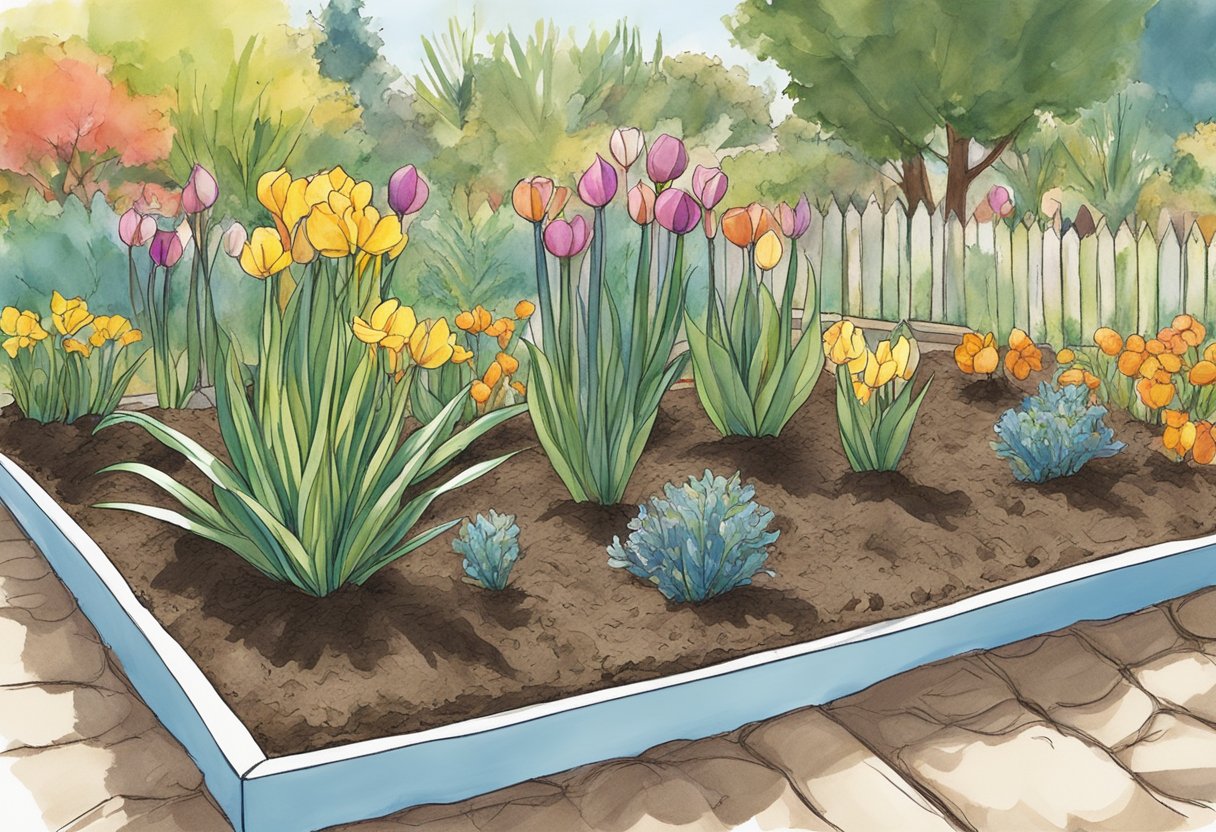Planting bulbs in Southern California comes with a unique set of rules, thanks to its distinct climate. Most know the area for its warm weather and mild winters, which is both a blessing and a challenge when introducing plants that are often accustomed to colder climates. To achieve a garden filled with colorful blooms, understanding the best time to plant bulbs is crucial.

In my experience gardening in Southern California, the optimal window for planting most bulbs is in the fall, before the soil cools down but late enough to avoid the hottest days of summer.
As a gardener in this region, I’ve learned that many common bulbs such as tulips and daffodils need a period of cold dormancy to bloom properly. Since Southern California doesn’t provide this naturally, we have to mimic these conditions. I store my bulbs in a paper bag within my refrigerator for at least six to eight weeks before planting. This chilling period tricks them into thinking they’ve experienced winter, ensuring a display of lovely blooms come spring.
JUMP TO TOPIC
Selecting the Right Bulbs for Your Garden
In Southern California, gardeners face unique climate conditions that must be considered to ensure a flourishing bulb garden. Choosing the right bulbs means understanding the varieties, taking the climate into account, and timing the planting for the best blooming results.
Understanding Bulb Varieties
When I look at bulb selection, I focus on those that are known to thrive in Southern California’s Mediterranean climate. Bulbs like tulips, daffodils, and crocus are popular choices.
Tulips: While beautiful, they require pre-chilling to simulate a cold winter.
Daffodils: More heat tolerant and naturalize well in the region.
Crocus: Small and early bloomers, crocus can be planted in clusters for striking displays.
Hyacinth and alliums: Both provide dramatic blooms and are suited to our climate, with hyacinth needing pre-chilling.
Climate Considerations for Southern California
The mild, wet winters and hot, dry summers here create a Mediterranean climate, which poses unique challenges and opportunities for bulb gardeners.
💥 It’s essential to select bulbs that can tolerate a lack of winter chill and adapt to dry summer conditions.
Timing Your Planting for Optimal Bloom
To achieve the brilliant bursts of spring color, timing the planting of your bulbs is critical. In our region, fall planting is optimal for most varieties to ensure they establish roots and are ready for a spring showcase.
| Bulb Type | Pre-Chill | Planting Season | Bloom Season |
|---|---|---|---|
| Tulips | Yes, 6-8 weeks | Fall | Spring |
| Daffodils | No | Fall | Spring |
| Crocus | No | Fall | Winter/Spring |
| Hyacinth | Yes, 6-8 weeks | Fall | Spring |
| Alliums | No | Fall | Spring/Summer |
Planting and Maintenance Techniques
Achieving a flourishing garden with bulbs in Southern California involves understanding the nuances of proper planting techniques and year-round maintenance. These foundational practices are the bedrock of a healthy and vibrant garden.
Proper Planting Depth and Spacing
💥 Planting Depth:
| Type of Bulb | Recommended Depth | Spacing |
|---|---|---|
| Tulips | 6 inches | 4-6 inches |
| Daffodils | 6-8 inches | 6-8 inches |
| Crocus | 3-4 inches | 3-4 inches |
I always ensure that each bulb is planted at the right depth and spacing for optimal sunlight exposure and growth.
Soil Preparation and Fertilization
Before planting, I prepare the soil by mixing in ample organic compost. This enhances soil fertility and drainage, crucial for bulb health.
Watering and Care Through the Seasons
Excess water can rot bulbs. I irrigate sparingly until the rainy season begins to ensure bulbs don’t sit in soggy soil.
In Southern California, bulbs need infrequent but deep irrigation to thrive. Post-planting, I avoid watering the garden until the fall rains naturally moisten the soil. As spring approaches and the bulbs sprout, I gradually increase watering to meet the growth demands.
Protecting Your Bulbs from Common Problems
In my experience, ensuring your bulbs flourish in Southern California involves proactive measures against pests, diseases, and climate-related challenges. Let’s go through specific strategies to protect your garden investments.
Pest Management and Deterrence
Contending with pests like squirrels can be daunting. These critters can dig up and eat bulbs, leading to a disappointing garden display. What I’ve found effective is:
- Using physical barriers: Chicken wire or mesh installed over the planting area can discourage digging.
- Repellents: Non-toxic repellents can keep squirrels at bay; however, applications need to be regular due to weathering.
Diseases and How to Prevent Them
Bulb rot and fungal infections are common issues. Here’s what I do:
- Proper Soil Preparation: Ensure good drainage to prevent waterlogged conditions where pathogens thrive.
- Clean Planting Practices: Always start with disease-free bulbs and clean tools to reduce disease spread.
💥 A little tip: Adding a thin layer of sand at the bottom of the planting hole helps improve drainage and prevent bulb rot.
Dealing with Climate Challenges
Southern California’s Mediterranean climate poses unique challenges like dry summers and mild winters. To navigate these:
- Mulching: A layer of mulch helps retain soil moisture and provides insulation against frost in winter gardens.
- Timely Watering: During prolonged dry spells, occasional deep watering encourages strong root growth.
Avoid overwatering, as it can lead to bulb rot, particularly during the cool, wet winter months.











